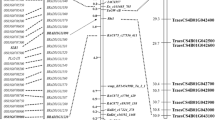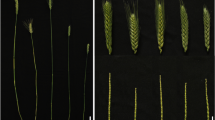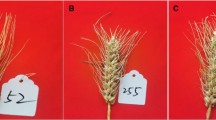Abstract
Key message
A major and stable QTL, QFn.sau-1B.2, which can explain 13.6% of the PVE in FN and has a positive effect on resistance in SGR, was mapped and validated.
Abstract
The falling number (FN) is considered one of the most important quality traits of wheat grain and is the most important quality evaluation index for wheat trade worldwide. The quantitative trait loci (QTLs) for FN were mapped in three years of experiments. 23, 30, and 58 QTLs were identified using the ICIM-BIP, ICIM-MET, and ICIM-EPI methods, respectively. Among them, seven QTLs were considered stable. QFn.sau-1B.2, which was mapped to the 1BL chromosome, can explain 13.6% of the phenotypic variation on average and is considered a major and stable QTL for FN. This QTL was mapped in a 1 cM interval and is flanked by the markers AX-110409346 and AX-108743901. Epistatic analysis indicated that QFN.sau-1B.2 has a strong influence on FN through both additive and epistatic effects. The Kompetitive Allele-Specific PCR marker KASP-AX-108743901, which is closely linked to QFn.sau-1B.2, was designed. The genetic effect of QFn.sau-1B.2 on FN was successfully confirmed in Chuannong18 × T1208 and CN17 × CN11 populations. Moreover, the results of the additive effects of favorable alleles for FN showed that the QTLs for FN had significant effects not only on FN but also on the resistance to spike germination. Within the interval of QFn.sau-1B.2, 147 high-confidence genes were found. According to the gene annotation and the transcriptome data, four genes might be associated with FN. QFn.sau-1B.2 may provide a new resource for the high-quality breeding of wheat in the future.






Similar content being viewed by others
Data availability
All experiments and data analyses were conducted in Sichuan, and the Wheat55K SNP genotyping was done at CapitalBio Technology Company in Beijing, China.
Code availability
Not applicable.
References
Barrero JM, Cavanagh C, Verbyla KL, Tibbits JF, Verbyla AP, Huang BE, Rosewarne GM, Stephen S, Wang P, Whan A, Rigault P, Hayden MJ, Gubler F (2015) Transcriptomic analysis of wheat near-isogenic lines identifies PM19-A1 and A2 as candidates for a major dormancy QTL. Genome Biol 16:93
Belitz HD, Wrosch G, Chieberle PS (2004) Cereal and cereal products. Food Chem 3:673–746
Börner A, Nagel M, Agacka-Mołdoch M, Gierke PU, Oberforster M, Albrecht T, Mohler V (2018) QTL analysis of falling number and seed longevity in wheat (Triticum aestivum L.). J Appl Genet 59:35–42
Cabral AL, Jordan MC, McCartney CA, You FM, Humphreys DG, MacLachlan R, Pozniak CJ (2014) Identification of candidate genes, regions and markers for pre-harvest sprouting resistance in wheat (Triticum aestivum L.). BMC Plant Biol 14:340
Cao S, Xu D, Hanif M, Xia X, He Z (2020) Genetic architecture underpinning yield component traits in wheat. Theor Appl Genet 133:1811–1823
Capron D, Mouzeyar S, Boulaflous A, Girousse C, Rustenholz C, Laugier C, Bouzidi MF (2012) Transcriptional profile analysis of E3 ligase and hormone related genes expressed during wheat grain development. BMC Plant Biol 12:35
Chaves MS, Martinelli JA, Wesp-Guterres C, Graichen FA, Brammer SP, Scagliusi SM, da Silva PR, Wiethölter P, Torres GAM, Lau Y, Consoli L, Chaves ALS (2013) The importance for food security of maintaining rust resistance in wheat. Food Secur 5:157–176
Eeden EV, Labuschagne MT (2012) Sprouting tolerance and falling number in South African hybrid bread wheat cultivars and their parent lines. J Cereal Sci 56:754–759
Feng N, He Z, Zhang Y, Xia X, Zhang Y (2013) QTL mapping of starch granule size in common wheat using recombinant inbred lines derived from a PH82-2/Neixiang 188 cross. Crop J 1:166–171
Fofana B, Humphreys DG, Rasul G, Cloutier S, Brlé-Babel A, Woods S, Lukow OM, Somers DJ (2009) Mapping quantitative trait loci controlling pre-harvest sprouting resistance in a red × white seeded spring wheat cross. Euphytica 165:509–521
Fradgley NS, Gardner K, Kerton M, Swarbreck SM, Bentley AR (2022) Trade-offs in the genetic control of functional and nutritional quality traits in UK winter wheat. Heredity 128:420–433
Guo Y, Zhang G, Guo B, Qu C, Li S (2020) QTL mapping for quality traits using a high-density genetic map of wheat. PLoS ONE 15:e0230601
Gupta PK, Balyan HS, Sharma S, Kumar R (2020) Genetics of yield, abiotic stress tolerance and biofortifcation in wheat (Triticum aestivum L.). Theor Appl Genet 133:1569–1602
Himi E, Maekawa M, Miura H, Noda K (2011) Development of PCR markers for Tamyb10 related to R-1, red grain color gene in wheat. Theor Appl Genet 122:1561–1576
Kettlewell PS (1993) Pre-harvest prediction of Hagberg falling number of wheat: some possible methods for the United Kingdom. Asp Appl Biol 36:257–266
Kunert A, Naz A, Dedeck O, Pillen K, Leon J (2007) AB-QTL analysis in winter wheat: I Synthetic hexaploidy wheat (T. turgidum ssp. dicoccoides × T. tauschii) as a source of favourable alleles for milling and baking quality traits. Theor Appl Genet 115:683–695
Li Q, Pan Z, Gao Y, Li T, Liang J, Zhang Z, Zhang H, Deng G, Long H, Yu M (2020) Quantitative trait locus (QTLs) mapping for quality traits of wheat based on high density genetic map combined with bulked segregant analysis RNA-seq (BSR-Seq) idicates that the basic 7S globulin gene is related to falling number. Front Plant Sci 11:600788
Li Z, Chen Y, Ou X, Wang M, Wang N, Li W, Deng Y, Diao Y, Sun Z, Luo Q, Li X, Zhao L, Yan T, Peng W, Jiang Q, Fang Y, Ren R, Tan F, Luo P, Ren T (2022) Identification of a stable major-effect quantitative trait locus for pre-harvest sprouting in common wheat (Triticum aestivum L.) via high-density SNP-based genotyping. Theor Appl Genet 135:4183–4195
Lunn GD, Kettlewell PS, Major BJ, Scott RK (2001) Effects of pericarp alpha-amylase activity on wheat (Triticum aestivum) Hagberg falling number. Ann Appl Biol 138:207–214
Ma S, Wang M, Wu J, Guo W, Chen Y, Li G, Wang Y, Shi W, Xia G, Fu D, Kang Z, Ni F (2021) WheatOmics: a platform combining multiple omics data to accelerate functional genomics studies in wheat. Mol Plant 14:1965–1968
Mamytova N, Kuzovlev V, Khakimzhanov A et al (2014) The contribution of different a-Amylase isoenzymes of the commodity grain spring wheat in the formation of falling number values. Appl Biochem Microbiol 50:531–537
Marcotuli I, Gadaleta A, Mangini G, Signorile AM, Zacheo SA, Blanco A, Simeone R, Colasuonno P (2017) Development of a high-density SNP-Based linkage map and detection of QTL for β-glucans, protein content, grain yield per spike and heading time in durum wheat. Int J Mol Sci 18:1329
Mares D, Mrva K (2008) Late-maturity alpha-amylase: low falling number in wheat in the absence of preharvest sprouting. J Cereal Sci 47:6–17
Meng L, Li HH, Zhang LY, Wang JK (2015) QTL IciMapping: Integrated software for genetic linkage map construction and quantitative trait locus mapping in biparental populations. Crop J 3:269–283
Mohler V, Albrecht T, Mrva K, Schweizer G, Hartl L (2014) Genetic analysis of falling number in three bi-parental common winter wheat populations. Plant Breeding 133:448–453
Pu Z, Ye X, Li Y, Shi B, Guo Z, Dai S, Ma J, Liu Z, Jiang Y, Li W, Jiang Q, Chen G, Wei Y, Zheng Y (2022) Identification and validation of novel loci associated with wheat quality through a genome-wide association study. J Integr Agric 11:3131–3147
Rasul G, Humphreys D, Brûlé-Babel A, McCartney CA, Knox RE, DePauw RM, Somers DJ (2009) Mapping QTLs for pre-harvest sprouting traits in the spring wheat cross ‘RL4452/AC Domain. Euphytica 168:363–378
Ren T, Fan T, Chen S, Li C, Chen Y, Ou X, Jiang Q, Ren Z, Tan F, Luo P, Chen C, Li Z (2021) Utilization of a Wheat55K SNP Array-derived high-density genetic map for high-resolution mapping of quantitative trait loci for important kernel-related traits in common wheat. Theor Appl Genet 134:807–821
Ren T, Fan T, Chen S, Chen Y, Ou X, Jiang Q, Peng W, Ren Z, Tan F, Luo P, Li Z (2022) Identification and validation of quantitative trait loci for functional stay green traits in common wheat (Triticum aestivum L.) via high-density SNP-based genotyping. Theor Appl Genet 135:1429–1441
Shao Y, Tsai M, He Y, Chen J, Wilson C, Lin AH (2019) Reduction of falling number in soft white spring wheat caused by an increased proportion of spherical B-type starch granules. Food Chem 284:140–148
Smith GP, Gooding MJ (1999) Models of wheat grain quality considering climate, cultivar and nitrogen effects. Agricculural and Forest Meteorology 94:159–170
Tai L, Wang H, Xu X, Sun W, Ju L, Liu W, Li W, Sun J, Chen K (2021) Pre-harvest sprouting in cereals: genetic and biochemical mechanisms. J Exp Bot 72:2857–2876
Tang H, Wang H, He M, Zhang M, Hu Y, Li Z, Ren T, Ren Z, Yan B (2017) QTL analysis for wheat falling number in a recombinant inbred line population segregated with 1BL/1RS translocation in a rainfed agricultural area of China. Euphytica 213:235
Thirugnanasambantham K, Durairaj S, Saravanan S, Karikalan K, Muralidaran S (2015) Role of ethylene response transcription factor (ERF) and its regulation in response to stress encountered by plants. Plant Mol Biol Rep 33:347–357
Wen D, Xu H, He M, Zhang C (2021) Proteomic analysis of wheat seeds produced under different nitrogen levels before and after germination. Food Chem 340:127937
Xu Z, Xia L, Chen M, Cheng X, Zhang R, Li L, Zhao Y, Lu Y, Ni Z, Liu L, Qiu Z, Ma Y (2007) Isolation and molecular characterization of the Triticum aestivum L. ethylene-responsive factor 1 (TaERF1) that increases multiple stress tolerance. Plant Mol Biol 65:719–732
Zhao C, Zhou J, Li C, You J, Liu Y, Tang H, Deng M, Xu Q, Zhang Y, Jiang Q, Chen G, Qi P, Jiang F, Wang J, Li W, Pu Z, Chen G, Jiang Y, Zheng Z, Liu C, Zheng Y, Wei Y, Ma J (2023) A major QTL simultaneously increases the number of spikelets per spike and thousand-kernel weight in a wheat line. Theor Appl Genet 136:213
Acknowledgments
We gratefully acknowledge the financial support from the Major Program of National Agricultural Science and Technology of China (NK20220607).
Funding
Major Program of National Agricultural Science and Technology of China (NK20220607), and College Students’ Innovative Entrepreneurial Training Plan Program (S202310626043).
Author information
Authors and Affiliations
Contributions
TR designed the experiments; TR created the RIL population; ZL, QL, YG, XL, XO, YD, SF, ZT, FT, and PL participated in phenotype measurement; QL and ZL participated in data analysis and processing; ZL and QL performed QTL analysis; FT performed the field management; TR wrote the manuscript. All authors participated in the research and approved the final manuscript.
Corresponding author
Ethics declarations
Conflict of interest
All authors declare that they have no conflict of interest.
Ethical approval
We declare that these experiments complied with the ethical standards in China.
Consent to participate
Not applicable.
Consent for publication
All authors contributed to the study and approved the final version for submission.
Additional information
Communicated by Susanne Dreisigacker.
Publisher's Note
Springer Nature remains neutral with regard to jurisdictional claims in published maps and institutional affiliations.
Supplementary Information
Below is the link to the electronic supplementary material.
122_2024_4588_MOESM1_ESM.docx
Fig. S1 Genotyping results of KASP markers related to FN, A: Genotyping results in the CT population; B: Genotyping results in the CC population. (DOCX 1242 KB)
Rights and permissions
Springer Nature or its licensor (e.g. a society or other partner) holds exclusive rights to this article under a publishing agreement with the author(s) or other rightsholder(s); author self-archiving of the accepted manuscript version of this article is solely governed by the terms of such publishing agreement and applicable law.
About this article
Cite this article
Li, Z., Luo, Q., Gan, Y. et al. Identification and validation of major and stable quantitative trait locus for falling number in common wheat (Triticum aestivum L.). Theor Appl Genet 137, 83 (2024). https://doi.org/10.1007/s00122-024-04588-y
Received:
Accepted:
Published:
DOI: https://doi.org/10.1007/s00122-024-04588-y




